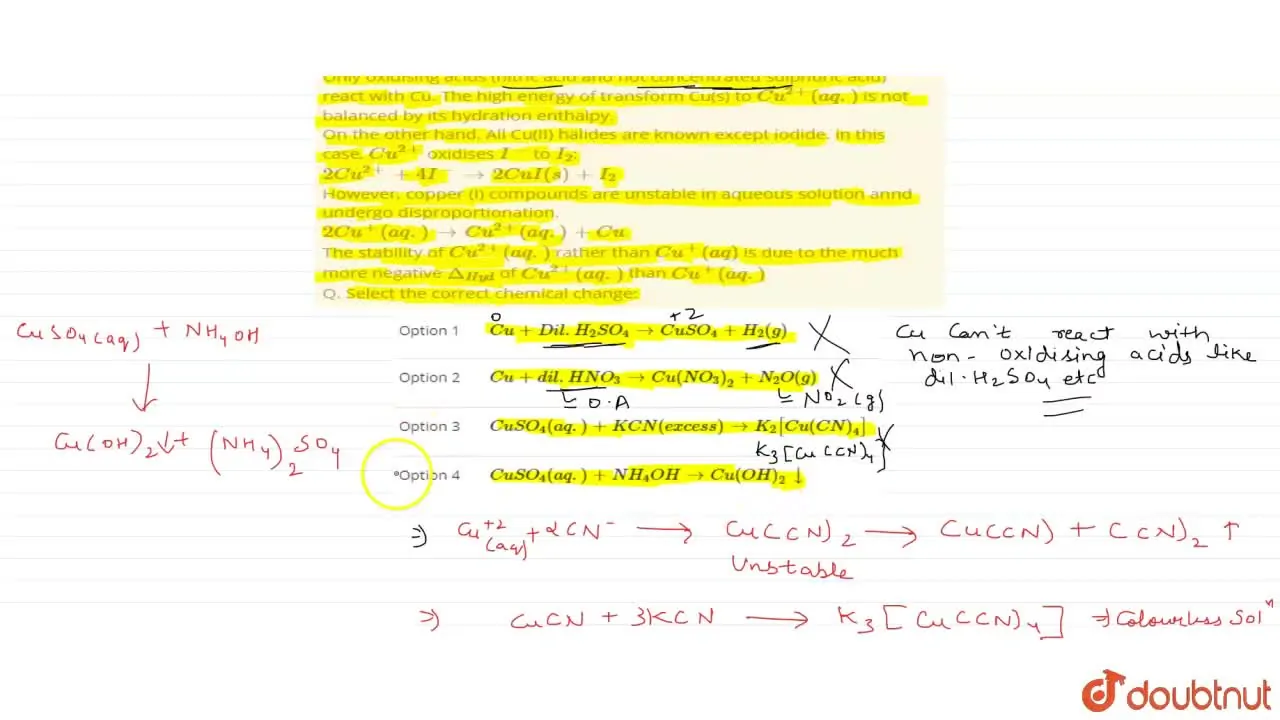The unique behaviour of CU, having a positive E∘ (reduction potential) accounts for its inability to liberate H2 from acids,. Only oxidising acids (nitric acid and hot concentrated sulphuric acid) react with Cu. The high energy of transform Cu(s) to Cu2+(aq.) is not balanced by its hydration enthalpy.
On the other hand, All Cu(II) halides are known except iodide. in this case, Cu2+ oxidises I− to I2:
2Cu2++4I−→2CuI(s)+I2
However, copper (I) compounds are unstable in aqueous solution annd undergo disproportionation.
2Cu+(aq.)→Cu2+(aq.)+Cu
The stability of Cu2+(aq.) rather than Cu+(aq) is due to the much more negative ΔHyd of Cu2+(aq.) than Cu+(aq.)
Q. Select the correct chemical change:
Cu+Dil.H2SO4→CuSO4+H2(g)
Cu+dil.HNO3→Cu(NO3)2+N2O(g)
CuSO4(aq.)+KCN(excess)→K2[Cu(CN)4]
CuSO4(aq.)+NH4OH→Cu(OH)2⏐↓
The correct Answer is:D
Cu2+(aq.)+2CN−(aq.)→Cu(CN)2UnstableI.M.R.−−−−→CuCN⏐⏐
⏐
⏐↓+(CN)2↑⏐
⏐
⏐⏐
CuCN⏐⏐
⏐↓+3KCNExcess⇔K3[Cu(CN)4]Colourless soln.
Related Playlists
- BOOK - VK JAISWAL ENGLISHCHAPTER - TYPES OF REACTIONSEXERCISE - ONE OR MORE ANSWERS IS/ARE CORRECT40videos
TYPES OF REACTIONS
- BOOK - VK JAISWAL ENGLISHCHAPTER - TYPES OF REACTIONSEXERCISE - MATCH THE COLUMN14videos
TYPES OF REACTIONS
- BOOK - VK JAISWAL ENGLISHCHAPTER - TYPES OF REACTIONSEXERCISE - LEVEL 2196videos
TYPES OF REACTIONS
- BOOK - VK JAISWAL ENGLISHCHAPTER - s-BLOCK ELEMENTSEXERCISE - SUBJECTIVE PROBLEMS2videos
s-BLOCK ELEMENTS
Similar Questions
The unique behaviour of CU, having a positive E∘ (reduction potential) accounts for its inability to liberate H2 from acids,. Only oxidising acids (nitric acid and hot concentrated sulphuric acid) react with Cu. The high energy of transform Cu(s) to Cu2+(aq.) is not balanced by its hydration enthalpy.
On the other hand, All Cu(II) halides are known except iodide. in this case, Cu2+ oxidises I− to I2:
2Cu2++4I−→2CuI(s)+I2
However, copper (I) compounds are unstable in aqueous solution annd undergo disproportionation.
2Cu+(aq.)→Cu2+(aq.)+Cu
The stability of Cu2+(aq.) rather than Cu+(aq) is due to the much more negative ΔHyd of Cu2+(aq.) than Cu+(aq.)
Q. Consider the following transformation:
CuSO4(aq.)+KI(excess)→product
Select the correct statement:View SolutionAll Cu(II) halides are known except the iodide. The reason for it is that
View SolutionAssertion (A) Cu2+ iodide is not known.
Reason (R ) Cu2+ oxidises I− to iodine.View SolutionAssertion: Aquated copper(I) cation undergoes disproportionation as:
2Cu+(aq)→Cu2+(aq)+Cu
Reason: Hydration energy of Cu2+ is higher than that of Cu+ which compensates second ionisation energy of Cu.View SolutionAssertion: Aquated copper(I) cation undergoes disproportionation as:
2Cu+(aq)→Cu2+(aq)+Cu
Reason: Hydration energy of Cu2+ is higher than that of Cu+ which compensates second ionisation energy of Cu.View SolutionAssertion (A) Cu2+ iodide is not known.
Reason (R ) Cu2+ oxidises I− to iodine.View SolutionCu2+(aq.) is unstable in solution and under goes simultaneous oxidation and reduction according to the reaction
2Cu+(aq.)⇔Cu2+(aq.)+Cu(s)
Choose the correct E∘ for the above reaction if
E∘Cu2+/Cu=0.34VandE∘Cu2+/Cu+=0.15VView SolutionThe reduction potential diagram for Cu in acid solution is :

Calculate X. Does Cu+ disproportionate in solution ?View SolutionCu+ ion is not stable in aqueous solution because because of dispropotionation reaction. E∘ value of disproportionation of Cu+ is
[E∘Cu2+/Cu+=+0.15V,E∘Cu2+/Cu=0.34V]View SolutionCu+ ion is not stable in aqueous solution because because of dispropotionation reaction. E∘ value of disproportionation of Cu+ is
[E∘Cu2+/Cu+=+0.15V,E∘Cu2+/Cu=0.34V]View Solution


